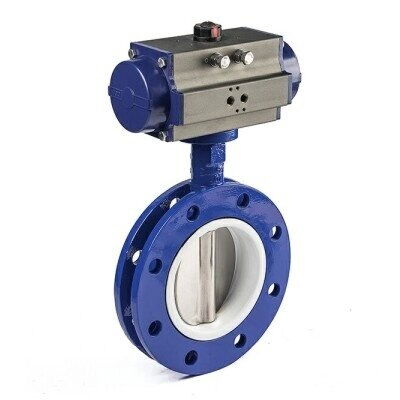Effective Maintenance Practices for Electric Butterfly Control Valves
Maintenance of lubrication systems is essential for the smooth operation of electric butterfly control valves in industrial and commercial settings. Proper lubrication prevents valve sticking, slow operation, and premature wear of moving parts. This article explores key maintenance practices of electric butterfly control valves including inspections, lubricant selection, cleaning, filtration, adherence to schedules, and component maintenance. These practices are critical for sustaining valve performance and minimizing downtime, ensuring reliable operation in various applications.
Maintenance of Lubrication Systems
Maintenance of lubrication systems is critical for ensuring the smooth and efficient operation of electric butterfly control valves in industrial and commercial settings. Proper lubrication helps prevent common issues such as valve sticking, slow operation, or premature wear of moving parts. Here are key aspects of maintaining lubrication systems.
1. Regular Inspection
Conduct routine inspections of the lubrication system to check for proper operation of oil misters or lubricators. Ensure that lubricant levels are adequate and that there are no leaks in the system. Any signs of oil contamination or degradation should be promptly addressed.
2. Lubricant Selection
Choose the appropriate lubricant recommended by the valve manufacturer. The lubricant should be compatible with the valve's materials and operating conditions. Using the wrong type of lubricant can lead to ineffective lubrication, increased friction, and accelerated wear of components.
3. Cleaning and Filtration
Keep lubrication points clean from dirt, dust, and debris. Contaminants can interfere with proper lubrication and cause abrasion on moving parts. Use filters or strainers in the lubrication system to prevent particles from entering critical areas.
4. Lubrication Schedule
Follow a regular lubrication schedule as recommended by the valve manufacturer. This schedule should include intervals for applying lubricant to specific components such as bearings, shafts, and seals. Over-lubrication can be as detrimental as under-lubrication, so adhere to specified quantities.
5. Cleaning and Maintenance of Components
Periodically clean lubrication system components, such as oil misters, lubricant reservoirs, and distribution lines. Replace lubrication system filters according to the manufacturer's recommendations to maintain optimal system performance.
Regular Replacement of Sealing Components
Regular replacement of sealing components is essential for maintaining the optimal performance and reliability of electric butterfly control valves over their operational lifespan. Here are important considerations and steps for this maintenance task.
1. Understanding Sealing Components
Sealing components such as valve core seals, valve stems, and valve seats play a crucial role in maintaining the integrity of the valve's sealing function. These components are subject to wear and degradation over time due to constant exposure to operating conditions and media.
2. Monitoring Wear and Performance
Regularly inspect sealing components for signs of wear, aging, or damage. Visual inspection can reveal cracks, tears, or distortion in seals, and wear patterns on valve stems and seats. Operational performance should also be monitored for any indications of decreased sealing effectiveness or leakage.
3. Replacement Schedule
Establish a preventive maintenance schedule for replacing sealing components based on the manufacturer's recommendations and operational conditions. Factors such as valve usage frequency, operating pressure, temperature fluctuations, and the nature of the media being handled should influence the replacement intervals.
4. Choosing Replacement Parts
Use genuine replacement parts recommended by the valve manufacturer to ensure compatibility and performance. Quality seals, valve stems, and seats designed specifically for the valve model and application will enhance sealing efficiency and longevity.
Maintenance of Solenoid Pilot Valves
Maintenance of solenoid pilot valves is crucial to ensure the reliable operation of electric butterfly control valves in industrial and commercial applications. Solenoid pilot valves play a critical role in controlling the actuation and direction of fluid flow within the valve assembly. Here's how to effectively maintain solenoid pilot valves.
1. Regular Inspection
Conduct routine inspections of solenoid pilot valves to check for any signs of wear, corrosion, or mechanical damage. Inspect electrical connections, solenoid coils, and the condition of moving parts such as the plunger or armature.
2. Cleaning and Lubrication
Keep solenoid pilot valves clean from dirt, dust, and debris that could interfere with their operation. Use compressed air or appropriate cleaning solutions to remove contaminants. Lubricate moving parts as recommended by the manufacturer to ensure smooth operation.
3. Testing Functionality
Test the functionality of solenoid pilot valves periodically. This includes checking for proper response to electrical signals, ensuring that the valve actuates correctly, and verifying that there are no sticking or hesitation issues during operation.
4. Inspecting Inlet and Exhaust Ports
Inspect and clean the inlet and exhaust ports of solenoid pilot valves to prevent blockages caused by debris, oil sludge, or other contaminants. Clearing these ports ensures proper fluid flow control and prevents potential operational failures.
5. Electrical Circuit Inspection
Verify the integrity of the electrical circuitry connected to the solenoid pilot valves. Check for loose connections, damaged wires, or corrosion that could affect electrical signal transmission. Ensure that the voltage supply meets the manufacturer's specifications.
6. Replacement of Faulty Components
Replace any worn-out or malfunctioning components promptly. This may include replacing solenoid coils, damaged seals, or worn-out gaskets to maintain optimal valve performance.
Maintaining well-functioning electric butterfly control valves not only ensures the continuity of industrial production but also serves as a critical measure for workplace safety and environmental protection. Operators should familiarize themselves with equipment manuals and maintenance guides, strictly adhering to operational and maintenance requirements to enhance equipment reliability and performance. This approach reduces downtime and maintenance costs caused by malfunctions.

